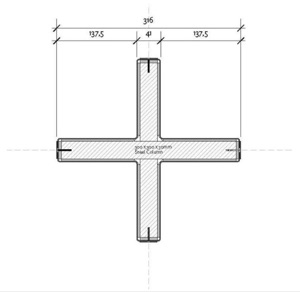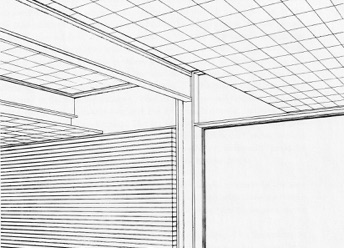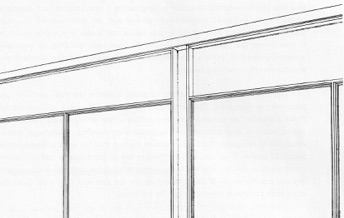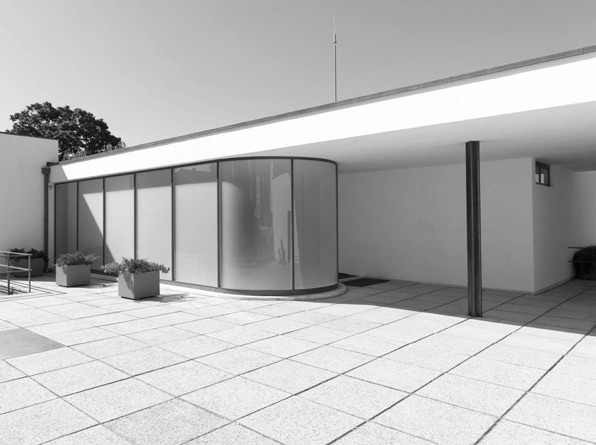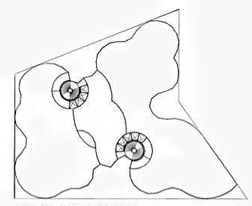
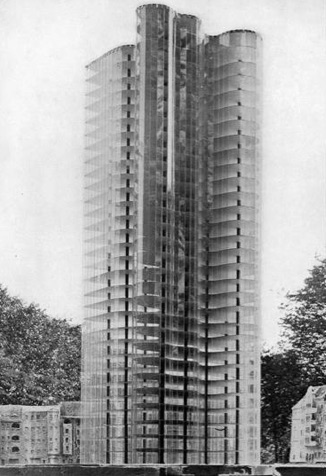





-
3)Courtyard House with Three Courts, Project, 1934; exterior elevation of fireplace wall, plan, and interior photo in living room facing fireplace.
-
*Drawings by: Maria Caridad Lopez.
-
*Rendering by: Jacob García Gómez and José Jaraíz.
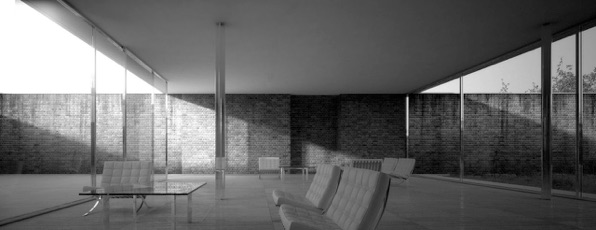
Mysticism or, in particular, Theosophy and Zen, is founded on spiritual certainty. It rejects appearances as an obscuring separation of the self from the real state of being. Reality for the individual is understood as a condition of oneness with the infinite. Authenticity of the self is found through the transcendental release of the individual consciousness into a single universe.
There is at least a superficial relationship between these two ideas and the two divergent characteristics of modern architecture we have already observed.
An architecture sympathetic to the existentialist would surely consist of specific forms juxtaposed and transformed by one another, their existences authenticated by their appearance to the self in a procession in time (as in Cubism or Le Corbusier’s architectural promenade).
The aesthetic conception of Cubism, Purism, and Collage can be seen as the province of understanding for every individual living in an existential world, expressing not the point of view of the individual’s taste, but the condition of interactive existences of people and objects.
It is this attitude which allows contemporary references into the vocabulary of modern architecture. The inclusion of ocean liners, airplanes and architectural grain silos becomes almost imperative as a consequence of the meaning given to “real” interactive existences.
- - -
But for Mies the existentialism rejected the transcendental and the concept of a single unity. Mies’s sympathy regarding a solution for this dilemma of the times would more naturally lean toward a concept of spiritual certainly like Theosophy, which maintained the idea of a universal oneness as the authentication of the modern self. “The thinker is an aspect of what is thought and the self an aspect of what it sees.”
Mies surely was familiar with these ideas via Berlage in the beginning and Mondrian later on. Both were interested in Theosophy. It describes the premise for the modern tendency to abstract minimalism. “On the one hand, this process reveals an identity of essence between intellect and the universe. On the other hand, the content is progressively emptying itself of its apparent substance: matter tends to be an empty form ... the reduction of reality to the void.”
The concept of the individual’s oneness with the infinite could form an acceptable modification of Aquinas’s a priori assumption of a world of unity, one responsive to the spirit of the time but still supporting his rational structure of universals.
An architecture corresponding to this view would find reality as the antithesis of form. As Mies said about his own work: “it has nothing to do with the invention of forms. The work as a non-form becomes a ‘mantra’ for the contemplation of ‘the significance of facts.’ ”
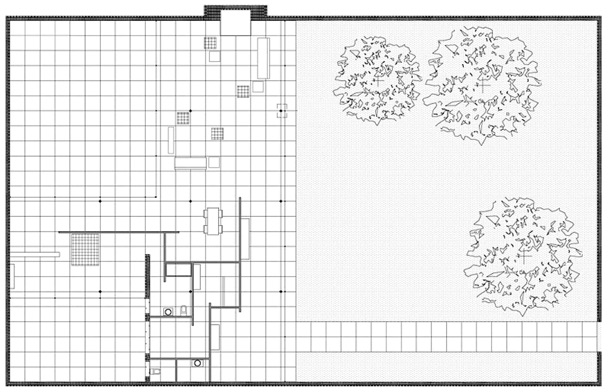

-
-
“In removing from the work all objects, the world is not separated from the spirit, but on the contrary put into balanced opposition with the spirit ... To love things in reality is to love them profoundly; it is to see them as a microcosmos in the macrocosmos. Only in this way can one achieve a universal expression of reality ... Art is not the expression of the appearance of reality as we see it.”
-
Whether or not Mies believed exactly in Mondrian’s statement which derives from Theosophy, this attitude does correspond to the characteristics of Mies’s style — the insistent minimalism, the ever-present background geometry, the avoidance of the expressive object and particularly the non-hierarchical concept of space seen as the infinite, undisturbed, universal void.
“Less is more” is like a Zen haiku. It states the transcendental universal unity, projecting the void as a symbol of ultimate reality.
It seems an accurate hypothesis for Mies’s work, corresponding to these ideas, that he dematerialized architecture to eliminate the object as form which obscured the transcendental reality, revealing an infinite universal space, itself unformed, conceived as the void. And in producing the experience of this conjunction of void and fact, it is the geometry, represented as a grid of uniform measured modules, which maintains and symbolizes the rational structure of knowledge.
This dematerialization of form, removing both intentional and circumstantial objects suggests that for Mies the ultimate symbol was not the frame as structure, but the grid, as independent geometry — the abstraction, not the fact. A history of his work in some ways can be characterized by the transfer of attention from frame to grid — not to form the ultimate single cell of structural frame, but in a sense, to eliminate structure in order to form a “column-free” space.
Even in the early glass skyscraper project of 1921, the plans show no columns (figure 4) and the perimeter form, although curvilinear and apparently expressive, is not a specific composition; the two cores themselves de-emphasize any possible centrality and have no formal relationship to the shape of the building’s edges, which actually appear to be randomly drawn.
It is definitely not a technological or Constructivist image. It is, if anything, organic in the sense of appearing to be, a natural, not man-made, shape, capable of growing or changing. The tower relates to the trees and the sky, not to the delicate clay townscape placed at its base for scale. There is a suggestion that the objects of the everyday world obscure the true connection between architecture and the order of nature.
The curvilinear perimeter suggests not so much a specific object but rather evokes the sense that this project is merely a fragment of a more general spatial order, a representative piece of a more universal condition.
But in this early glass skyscraper the missing element is geometry, specifically the grid which gained importance as Mies’s work developed. One suspects that if the columns had been drawn in the skyscraper plan, their placement would have been conditioned not by a separate geometry, but by the shape of the perimeter and the necessity for a constant cantilever.
Rendering the columns in the plan would have made the whole thing appear like a group of trees, a much too romantic image for Mies. In order that the structure itself not become expressive and so dominate the architectural idea, it must be subordinated to something else, something more enigmatic.
The geometric grid and its integral relationship to structure is first manifest in his work with the appearance of the cruciform column. It is significant that Mies avoided the convention of the round column, which in its abstraction as a cylinder is an autonomous object whose existence generates a strong radiating influence on the space around it (figure 5).
The cruciform column, however, is a more indefinite object. Made of polished chrome, it appears insubstantial and so capable of interpretation. It can represent the intersections of a spatial matrix, the materialization at a point of an a priori spatial order, the geometric grid. The column’s form implies a horizontal extension, a plane spatially connecting to the next column and perhaps infinitely beyond the last column. It is not a closed or confined form. Its extruded shape is non-specific and provides no clear vertical termination. It does not seem to hold up the ceiling as supporting structure, but suggests a virtual and symbolic grid extending beyond the floor and roof.
-
4)Glass Skyscraper Project, model and plan, 1922
-
-
The columns shown as long cantilevers in model, but not shown in plan, indicate that structure was not a paramount interest here.
The importance of the grid and its integrated relationship to the cruciform column can be seen in all the houses done in Germany after the Barcelona Pavilion (except the housing for the Berlin Building Exhibition).
But looking specifically at the House with Three Courts in plan and perspective, it is apparent that the gridded square paving is intended to represent a pervasive geometry ordering the interior and exterior spaces, but blurring the distinction between them.
The continuity of the spaces, their neutrality, and the constant presence of the grid as an idea is reinforced by converting all partitions and roofs into planes which don’t align with the grid in at least one direction. Thus he avoids cellular volumetric spaces and implies that the grid is independent and unaffected by the existence of particular circumstantial form.
In plan the columns are simply the intersection points of this abstracted geometry. Even at the Tugendhat House, where the grid is not expressed on the main floor paving, a cruciform column confronts us outdoors at the entrance, rising symbolically, out of the gridded exterior paving, to thematically establish the underlying spatial concept of the house (figure 6).
- - -
-
6)Plan and view of entrance, Tugendhat House, Brno, Czech Republic, 1931
-
The cruciform column is an exterior declaration of the order to be found throughout the house. The next column is inside the glass stair wall that one turns around descending to the main level.
It is more a marker of space than a substantive structural support. Like a shiny Brancusi sculpture, the “column” stands between floor and ceiling grids, an ethereal abstraction made of two mirrored planes that reflect the space around them and have their own illusion of depth and transparency.
-
5)The mirror-finished cruciform column used in early work.
Beginning at IIT (the Illinois Institute of Technology), the structure and grid begin to engage in a different dialogue. The column is no longer cruciform, but is forced into its rectangle of fireproofing and begins to receive less attention. It is retracted from its position of prominence, merging with interior walls, and gives way to an independent gridded skin of steel and brick as the presentation of the building’s geometric “structure.”
The column, when it does appear, is now a hollow “H” shape sometimes reading as a dematerialized void, as in the girder construction of the IIT Library. Here the column imbedded in the context of the wall emphasizes the space between its own flanges. The beam appears to pass through the almost invisible web. The continuous welded flanges of column and girders give the ambiguous sensation of the column being only a gap between the jambs of the window and wall framing (figure 7).
The structure at IIT did not become more prominent by becoming rectangular, but less, as it merged with the wall and the geometric grid in a new way. When cellular room plans had to be made and the space couldn’t be seen as literally continuous, the abstract conception of gridded space could maintain the universal quality in a virtual sense, extending through the necessary opacity of the walls, with the ceiling above continuing through transoms and clearstories.
For example, on the long elevation of the Chemical Engineering Building, we are not presented with the structure itself, but with a more frequent rhythm of a steel grid of extruded “I-beams” infilled with windows and brick panels. The columns themselves are recessed behind the wall; they are presented as exposed concrete and not steel. The column is no longer free, but engages the back of the wall without a corresponding expression on the exterior. The structure is retracted from our attention and veiled in a skin of abstracted geometry (figure 8).
As with the cruciform column, the history of Mies’s brick masonry also comes to an end at IIT. It started as both a load-bearing structure and an expressive element in the early brick houses, to become merely a “framing” boundary in the court houses with an occasional supporting role, replacing the last row of columns. It is then disengaged from all its structural and expressive functions in the buildings at IIT where it acts merely as infill, the steel grid breaking up any continuity as brick wall.
-
7)Exterior and interior details of steel column/beam joints for the IIT Library and Administration Building.
-
-
The standard wide-flange rolled sections of the beams and glass stops are welded onto the outer flanges of the column inverting the reading of its support. The column web becomes a hollow gap and the continuous window frames to its side seem to be holding up the roof.
-
8)Alumni Memorial Hall, IIT Campus, 1945
-
Although the facades suggest an architecture of exposed steel structure, the actual columns are hidden behind the continuous and regular steel-framed grid. It is an architectural language of geometry and systematic spatial subdivision, not an architecture of tangible structural expression.
Study of north wall
Interior view showing relation of structure to ceiling


-
On the interior, cross joists seem to pass through the column’s web as if it had been dematerialized.
5
6
7
8

Peterson Littenberg Architecture and Urban Design 131 East 66th Street, New York, NY 10065 Telephone (212) 772-7114 Website by Architectural Webdesign Wind powered by MacHighway
